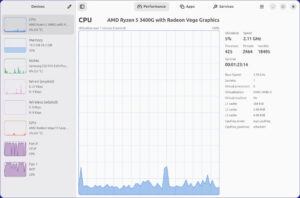I’m a sucker for every kind of “Top Five” (or Top 10 or Top 20) list there is. I love reading them and I enjoy writing them. There’s just one thing I’ve learned, never take them seriously. They’re just a way to have fun. They never speak anything like the whole truth, unless they’re listing something based on quantity, like the five best selling brands of soda. Even then, pay attention to who’s counting the quantity. Pepsi would probably come up with a different list than Coke.
There’s obviously no such thing as the five best Linux distros. There can’t be. To begin with, the category is way too broad and begs the question, the five best Linux distros for what? You wouldn’t likely see Red Hat or CentOS included on anybody’s list of best desktop distros, but they’d most likely be close to the top of anybody’s server distro list.
What if we confined our list to everyday use? What are the five best distros for the desktop–which would include the laptop, of course? Well, that too would depend on a lot of things, wouldn’t it?
Are we looking for distros that’ll keep an old underpowered box working until finances improve? That list might include distros such as Puppy Linux, which has a download size of only 132.6 MB or CrunchBang, which will work with only 128 MB RAM but which might not be completely appropriate for new users.
A five best list for new Linux users would be completely different. Here we might expect to see distros such as Linux Mint, which topped the list in our recent Best Newbie Distro poll, or Mageia, a fork of Mandrake /Mandriva, the granddaddy of all user friendly distros.

Even within the boundaries of these categories, we can’t really define a “five best.” Why? Because we have to consider the user. We’re all different. We have different preferences. We’ve developed different workflow patterns for getting things done when working. We even have different ways of entertaining ourselves when playing.
My roommate can sit for hours playing the simple game “Spider Solitare.” Myself, I won’t allow a game to be installed on one of my boxes. As they say, I don’t play games. But I do spend far too much time socializing with old friends in faraway places on Facebook and living in the 1960s by watching old clips of music on YouTube. Roommate does the YouTube thing too, as long as Cher or Adele is involved.
Some people want their computers to have every whistle and bell readily available, so their five best Linux distros lists would undoubtedly include distros that default to KDE. Others might’ve come to Linux by way of Apple and appreciate the user experience offered by Unity on Ubuntu. Others might find that desktop environments like KDE and GNOME get in the way and use too many resources. These people’s ten best Linux distros lists would include distros that install with a minimalist desktop like LXDE or a lightweight window manager such as Enlightenment.
All that being said and being true, Five Best or Top Five lists are still fun and most of us will continue to read them. I’ll even continue to try my hand at writing them every now and again. I think we read them because we want to see how our favorite distro fares. Often, however, we learn about a distro, a program, an application, or whatever’s being covered in the list that’s new to us–and that’s always a good thing.
Just keep in mind, there really isn’t a best Linux distro, or even a list of five best Linux distros. There’s only a best distro for you, the job you need it to do and the equipment on which you need it to operate.
Christine Hall has been a journalist since 1971. In 2001, she began writing a weekly consumer computer column and started covering Linux and FOSS in 2002 after making the switch to GNU/Linux. Follow her on Twitter: @BrideOfLinux




“Just keep in mind, there really isn’t a best Linux distro, or even a list of five best Linux distros. There’s only a best distro for you, the job you need it to do and the equipment on which you need it to operate.”
No better way of putting it :)!
I agree wholeheartedly! One man’s “Trash” is another man’s “Treasure”! I love Fedora and Debian…..
You’re right in what your saying every Linux user has their own favorite distribution, mine is Ultimate Edition 3.5 everything works out of the box Period, I personally download every distribution releases and test them out, I skip downloading the commercial distributions Ubuntu, Fedora, OpenSuse and Mint. Over the last week I have downloaded 14 new releases some of them are brilliants distributions, The Distros I recommend are Ultimate, Zorin-OS, ArtistX Antix, Linux Lite, Luninux, Vinux (for the Blind)
“Just keep in mind, there really isn’t a best Linux distro, or even a list of five best Linux distros. There’s only a best distro for you . . . .”
No truer words were spoken, and thanks for that observation to wrap up an insightful article.
I want to point out something about CrunchBang. It may have a reputation of being “difficult to use” (unwarranted in my opinion) because it uses the Openbox window manager as opposed to having a desktop environment, but the learning curve is not that steep for anyone with, at a minimum, a couple of IQ points to rub together.
I mean, seriously — it’s not like it’s Arch or Gentoo.
Dear Arch and Gentoo users — the last line in my previous comment is a joke. Ha ha. Apologies for the “joke” tags and smileys being left off. 🙂
I, for one, thought that was pretty funny, Larry. I’m not sure you needed to apologize. 🙂
Oh, and thanks for the kind words. In fact, thanks to everybody for the kind words!
Of course this is correct. Here’s some of the distributions I’ve used or consider using for various purposes.
Server: Debian, CentOS, Scientific Linux, Slackware
Lightweight: Puppy, Crunchbang, Bodhi, Debian (with LXDE), Slackware, Antix
New user friendly desktop: Xubuntu or Ubuntu Studio, Mint, Kubuntu, Mageia, (perhaps add Salix XFCE, though it’s slightly more advanced)
Advanced user desktop: new user distributions plus lightweight distributions (perhaps minus Puppy)
Of course this list is hardly comprehensive since there are probably distributions I’ve forgotton to mention and there are plenty of distributions I’ve never tried or perhaps even heard of. That’s why in certain ways the tremendous number of distributions available is a good thing, even though people new to Linux can find the sheer number of choices intimidating.
I have to agree that line everyone talks about really is excellent.
The problem is Linux users take their cues from others in the tech world, namely the fruit loving crowd, and act like their distro is a family member and they take every perceived negative comment as a direct attack on ‘their’ distro.
The Buntu kool aid crowd is very much in this mold.
The great strengths of Linux is the choice we have in desktops which is guaranteed to give you a better chance to find a desktop that suits your needs than the ‘take it or leave it’ of the proprietary world.
I compare it to BaskinRobbins. Not everyone likes the same flavours, so you cant expect one desktop to serve all people.
I dont like vanilla ice cream and I dont like Gnome (or other DE that dont allow me to configure the desktop how I want) but I know very well that other people do. The existence of vanilla ice cream or another desktop in no way affects my enjoyment of my favourites, yet people feel otherwise.
When swithcing a Windows user over, how many Linux users will offer a newb the chance to see which desktop they like better?
Its usually the desktop (and distro) that Linux guy uses that gets pimped to the newb. To actually offer another choice but the one you use feels like cheating on their spouse for many users. Im not even exaggerating here.
WHen choosing which Linux distro or desktop there is only ONE rule that matters: the user knows best. Not Joe Linux, or Bob Geekwriter or Claude the coder. The user knows best what he likes.
To think that there is a one size fits all for the desktop that will please everone is just as idiotic as saying that everyone should love vanilla ice cream and not chocolate (or Cherry Garcia).
And just like in real life-marriage, we get bored after a while and find a new, more exciting distro to which we pledge our devotion forgetting that not a few years ago we were singing the praises of another.
Actully, the Top Three Best Linux Distros for the desktop are:
1.Ubuntu with the slick Unity interface.
2.Open SUSE
3.Debian base
These are not respins. They are backed by major companies.
No fly by night communty distros on this list.
This could be, THE best “best Linux distros” review I’ve read in a looooong time. Keep up the good work.
*This review has been classified as a White House approved review*
For me, the most friendly, even not only on the ease of installation ( + very fast working speed), but on the accuracy of my hardware detection, was Kubuntu 12.04 LTS 🙂
To me each distro is a tool for someone to use. How I judge a distro is two fold: does it meet the objectives of the developers and does it suit me and my needs. The first is fairly objective for a well designed distro and every distro mentioned does meet their stated goals very well. The second part is mostly subjective and its about me and not you. Personally, I dislike certain DEs, not because they are technically bad but they do not feel right to me. But the strength of Linux is that underneath there is a common core but there are numerous flavors to enjoy. The analogy to Baskin-Robbins is apt.